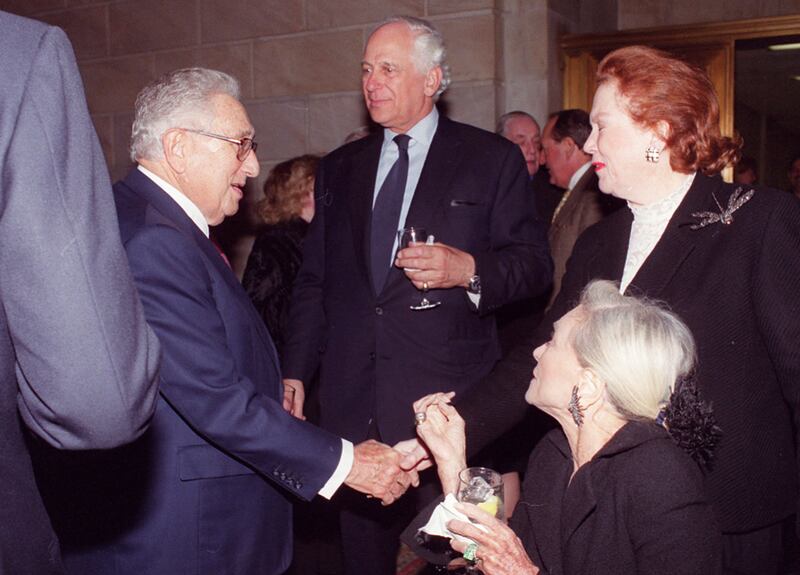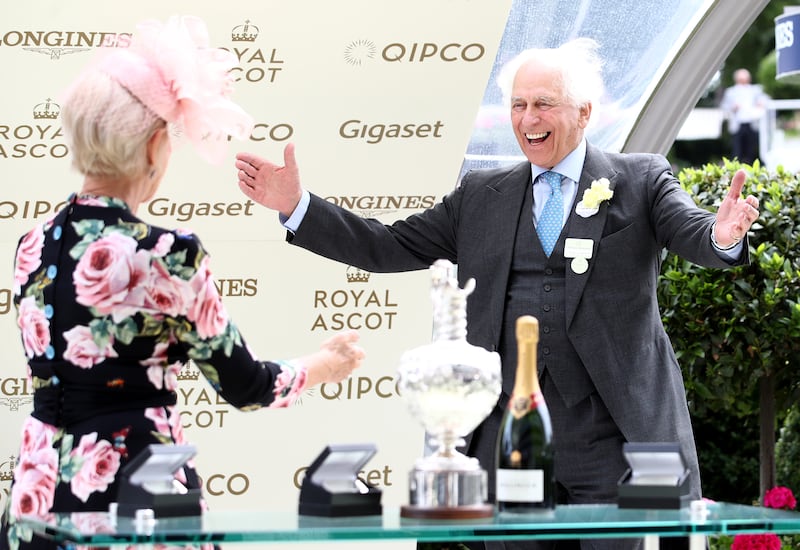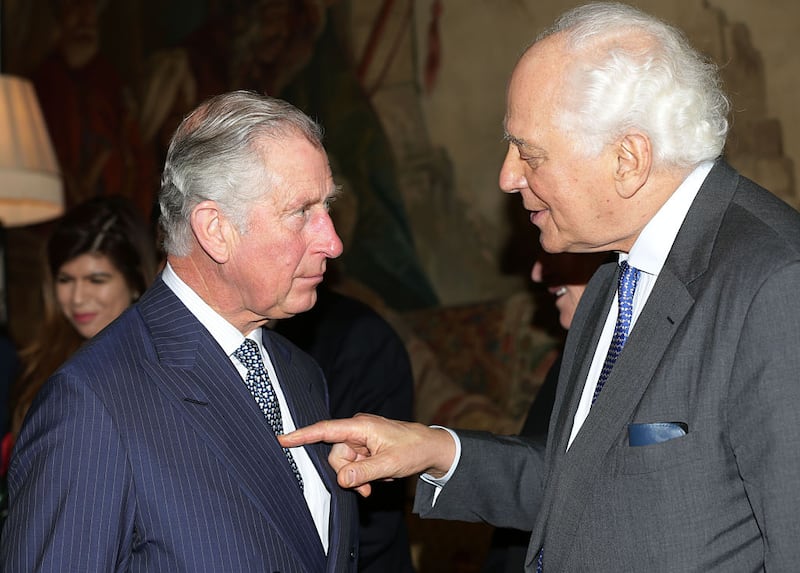Born 29th August, 1931
Died 7th November 2022
Evelyn de Rothschild, who as a London scion of the European banking dynasty helped Britain privatise its railroads, steel and coal in the tradition of his ancestors, who had helped finance the acquisition of the Suez Canal and the defeat of Napoleon, died on Monday evening at his home in London. He was 91.
The Rothschild Archive, which was founded by the Rothschild family, confirmed the death.
Ukraine fears nuclear plants are in Russia’s sights as missile strikes bring winter blackouts
‘I know what happened in that room’: the full story of the Conor McGregor case
I don’t want my neighbour to install an air-con unit encroaching on my garden. What can I do?
Brendan Mullin: the case of a ‘bank for the rich’ and the mystery €500,000
With his love of racehorses, sports cars, parties and excursions abroad, Rothschild might have become an international playboy. He failed economics and dropped out of Cambridge University, seemed happier on polo grounds than in banking circles in the city, and had little taste for high finance or investment strategies.
But the Rothschild name and history weighed upon him. Evelyn de Rothschild’s father was the chair, and his great-great-grandfather the founder, of NM Rothschild & Sons, the British branch of the family banking empire that began in 18th-century Frankfurt, Germany, and that, with its networks of couriers and spies, financial wizardry and political alliances, spread across Europe, making fortunes and influencing the destinies of nations for 200 years.
The Rothschilds had financed the armies of Europe in the Napoleonic Wars, salvaged the Bank of England in a liquidity crisis, were instrumental in passage of the Slavery Abolition Act of 1833, and financed Britain’s 1875 purchase of a controlling interest in the Suez Canal. It had even helped finance construction of the Underground, London’s subway system.
So after apprenticeships in New York and Toronto, Evelyn de Rothschild in 1957 joined NM Rothschild as a partner-in-training. Over two decades, colleagues said, he mastered the intricacies of a boutique bank trying to survive in a globalised world of financial institutions, some with 200,000 employees and trillion-dollar assets. His bank had only 600 employees and assets of $7 billion (€7 billion), but it had the storied Rothschild name.
And Rothschild, who rose to chair in 1976, used it to advantage. Like his forebears, he promoted strong ties with Britain’s government, news media and financial and business communities. He became chair of The Economist and director of Lord Beaverbrook’s newspaper group, chair of the British Merchant Banking & Securities House Association and a financial adviser to Queen Elizabeth II, who knighted him in 1989.

During the Conservative government of British prime minister Margaret Thatcher, from 1979 to 1990, Rothschild helped fulfil her signature policy of privatisation, selling state-owned industries and other assets to private companies, ostensibly to improve their productivity, increase competition, cut workforces, weaken trade unions and raise funds for a government beleaguered by strikes and a national recession.
With Rothschild and his bankers arranging sales, and in some cases helping to negotiate terms, the Thatcher government divested itself of nationalised oil, gas and steel industries, state-owned technology companies, regional electric grids and other interests. In the 1990s, British prime minister John Major similarly privatised British Rail and the remnants of a coal mining industry decimated by strikes and shutdowns.
As mergers swallowed up smaller financial institutions in a growing concentration of global banking power in the 1980s, Rothschild was credited by historians with protecting the Rothschild name from what he regarded as unsavory business and preserving its prized independence, which had been threatened by outside pressures and internal disunity.
Since the 1760s, when the patriarch Mayer Amschel Rothschild founded the dynasty in Frankfurt and sent four of his five sons – the five arrows in the family crest – to establish four more businesses in London, Paris, Vienna and Naples, the Rothschilds had been a partnership whose wealth and family ties had been a bulwark. But in the 20th century, world wars, the Great Depression and other strains had disrupted that alliance.
To rebuild the Old World partnership, Evelyn de Rothschild led a successful effort to reunify disparate family interests under a Swiss-based canopy, Rothschilds Continuation Holdings, which held stakes in Rothschild firms in Britain, France, the United States, the Netherlands, Australia, Hong Kong, Singapore and other locales. Rothschild was its chair from 1982 until 2003.
“The first important strength of the family is unity,” he told The New York Times in 1996.
Niall Ferguson, the British economic historian, wrote in The House of Rothschild (1998), that Rothschild believed “that the Rothschilds could combine the traditional virtues of the family firm with a genuinely global reach by constructing a modern version of the old Rothschild system: at the centre a closely knit group of family-controlled companies with an expanding network of agencies and associates with varying degrees of autonomy”.

Evelyn Robert Adrian de Rothschild was born in London on August 29th, 1931, to Anthony Gustav de Rothschild and French-born Yvonne Lydia Louise (Cahen d’Anvers) de Rothschild. His great-great-grandfather, Nathan Mayer de Rothschild, had founded the London bank in 1811 and helped finance the Duke of Wellington’s defeat of Napoleon at Waterloo in 1815.
Home was Ascott House, his family’s rambling manor and 3,200-acre estate in Buckinghamshire. Evelyn de Rothschild attended the venerable boarding school Harrow but, like many English children, was sent to the United States during the second World War. After the war, he studied history at Trinity College, Cambridge, but dropped out. Wealthy and sociable, he was for years one of England’s most eligible bachelors. He became a successful owner and breeder of racehorses.
His first marriage, to Jeannette Bishop in 1966, ended in divorce in 1971. In 1973, he married Victoria Lou Schott. They had three children, Jessica, Anthony and David, and were divorced in 2000. That year, he married Lynn Forester, an American lawyer and business-person who founded FirstMark Communications, a wireless broadband internet service in the US and Europe. She had two sons, Benjamin and John, by a previous marriage to New York City politician Andrew Stein.
Rothschild’s survivors include his wife and his children from his second marriage.
At the invitation by former US president Bill Clinton, Evelyn de Rothschild and Lady de Rothschild, as she was known by virtue of her marriage to a knight, spent part of their honeymoon at the White House.
The couple divided their time among homes in New York and London; a summer home on Martha’s Vineyard, Massachusetts; and Ascott House.
Evelyn de Rothschild, whose net worth has been variously estimated at $3 billion to $20 billion, retired as chair of the London bank in 2003 and was succeeded by his cousin, Baron David René de Rothschild, chair of the family’s French bank, in a restructuring that merged the two banks under Rothschilds Continuation Holdings.

Evelyn de Rothschild, a white-haired patrician who rarely gave interviews, told the Canadian magazine Maclean’s in 1998 that, to an old-fashioned banker accustomed to decorous transactions, investment finance had become almost unrecognisable in an era of hedge funds, derivatives, computer transactions and offshore tax havens.
“It has, I think, 400 banks,” he said, using the Cayman Islands as an example, “and you get all these people offshore paying no taxes, getting lines of credit – billions of dollars – and speculating against some poor country.”
“These computer systems now are dealing in trillions and trillions of dollars,” he added. “It’s a gambling casino.”
Asked if tighter international regulations were needed, Rothschild said, “Absolutely. But no one knows how to do it. How do you regulate someone sitting in the Bahamas or in Barbados with a satellite transmission system? You can be clobbered by a 16-year-old in a garage moving $5 billion from one account to another.” – This article originally appeared in The New York Times.




